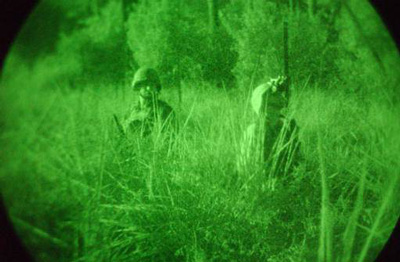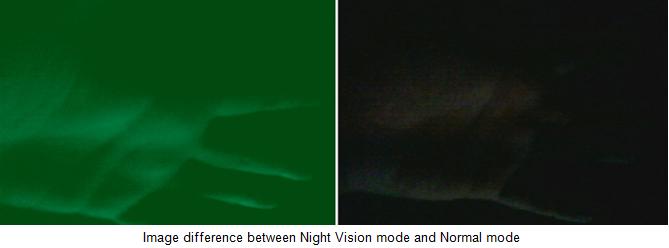‘And then the troops, unnoticed, surrounded whole of the desert city in that dark night, which certainly was all green for them’, we must have come across such lines in some or other war related article. Well, as quite a number of people do know that what does the word ‘green here refers to, very few are able to tell the deep insights about it. This article takes every inch of that green and explains its cause, the Night Vision Technology .

Fig. 1: An Image of Night Vision
Night Vision Technology, as the name suggests, is the expertise that makes us capable to see in the night without using any external light source such as a torch or a lamp. Highly advanced light sensitive cameras are used in this technology that produce clear visible images at night which the naked eye can’t do. Since the human eye is quite sensitive to green colour which falls in the middle of the spectrum, these cameras have green phosphor which gives the green colour to the Night Vision Cameras.

Fig. 2: Image Showing Comparison Between Night and Normal Vision Mode
History
Night Vision technology has been under research since Pre-World War II. However, a defined shape came post World War II, i.e., in early 1950s. This is when Generation-0 for Night Vision was developed. Devices that surfaced during this generation were bulky and expensive. The basic principle followed was using the light of the InfraRed region for the purpose of viewing. These early devices had their focus on image covering rather than giving sharp and intensified images. Since the drawbacks were more, the need to have an advanced system was realized quite promptly and within a decade, Generation-1 of night vision technology marked its presence.
1960s was the time, when the Vietnam war had taken a fiercer pace and victory demanded better use of the technology. Following the need, inventions in the night vision came up and were quickly adopted by the war nations. Generation-1 night vision gadgets didn’t have any source of light unlike the previous generation, as they were well advanced to use the little amount of light present in the environment. Even though less bulky and more efficient, these optical sensors needed moonlight to function properly. The images produced were ambiguous at the edges of the lens. But those who were equipped with this technology got a straight edge over the rivals as don’t had it found no alternatives than to protect them or use illuminations all night long. The improvements in the image intensifier tube or the ITT were mainly responsible for evolution of new generations in night vision technology.
Generation-2 came up during the 70s when some remarkable achievements in physics and optical phenomena could be actually transformed into other forms. Devices in this generation were loaded with image intensifiers which were basically photo cathodes that came along with micro channel plates or MCPs. These MCPs detect electrons whose frequency doesn’t come in the visible region of the light spectrum. This fairly solved the problem of unambiguous images as well as gave a well intensified and resolved image which restricted the life of the tube to be around 1000 hours.
In Generation-3, arrival of Gallium Arsenide as photocathode was seen. This, along with more advanced ion barrier film, increased the amount to which the image could be intensified by MCP and the intensifier tube’s life also increased by 1000 hours. Generation-3 devices are widely used and serve as the prime night vision devices for the US Army.
The gating technologies for power input stand as the benchmarks for Generation-4 of night vision technology as they confiscate the ion barriers and give best resolved form of the image. Amazingly efficient in the low light, Generation-4 devices are still considered in Generation-3 by the US Army.
Even though Generation-3 is the most used, Generation-2 devices are used for non armed and civilian purposes. At present, night vision devices can last for more than 10,000 hours and can give a fair vision of around 1000 metres in a fully moonlit environment.
Working
How Night Vision Technology works
Every Night Vision device is actually a combination of a number of devices that work on different technologies. Before taking deep insight of the devices, it is to be kept in mind that these devices do the work of Eye when it’s deep dark. So, the build of the device will be something that can be compared to the Eye. At the very beginning, we have a front lens that actually takes up whatever amount of light that is there in the environment. Following the front lens is the photocathode which forms over 3/4th costs of the device.
Now, photocathode is an intensifier that gives more brightness to every component of the light rays captured. Following the photocathode is the closely placed Micro Channel Plate (MCP). MCP detects electrons at various frequencies of light and constructs a charge pulse for every photon that strikes it. Hence, use of an MCP makes detection of the weakest component of light possible that further proves to be a boon for light amplification. Next to it is the high voltage power supply which, as its name says, provides power supply to the device. Over time, improvements have been made on the power supplies so that longer lives can be achieved. A phosphorous screen is attached before the eye screen which is responsible for the green image that is formed. Due to various chemical and physical processes that happen inside the device, electrons fall off the visible region of light. The phosphorous lens tunes the frequencies of these electrons into the visible region and hence a proper image is then transmitted to the eye piece.

Fig. 3: Simple Block Diagram Showing Electron Travelling Path for Night Vision Technology
Hence, in a night lit vision device, photons and electrons are detected and amplified using various components that work in synchronous behaviour like the human eye, thereby giving sheer clear image that can be perceived and understood by the human eye quite easily.
Execution Attributes
Execution Attributes
Important characteristics that define the performance of night vision devices are:
· The extent to which to which the device is sensitive to light. The more sensitive a device is, better are the chances that even dimmest of the light amplitudes. Also termed as photoresponse, it is measured in microamperes per lumen of light.
· The signal to noise ratio should be as low as possible so that the image produced as fine and does not contain the disturbances that are induced to the surrounding atmosphere or components of device.
· Resolution should be optimum enough so that even higher magnification images are clear enough to be visible.
Whenever a night vision device is used, some facts are to be kept in mind so that various aspects of the device are explained. Surface colours and patterns directly have an impact on the image produced. A darker image will be formed for the objects that are dull in texture and vice versa for bright textured objects.
Presence of rain, fog, smog and various other forms of water precipitation can have an adverse effect on the performance of the device. This is because the devices are quite responsive to even a slight amount of light and presence of water can give rise to various light phenomena which may not give the exact output that one desires to get from a night vision device.
It might happen that the image produced can have one or two dark spots. Throughout the time the device is used, these spots remain constant. Termed as photocathode spots, these spots are intrinsic characteristics of the night vision device and one should not termed the device to be defective if one or two spots are found.
Application & Future
Applications
Night vision technology was invented keeping various scenarios of war in mind. In fact, US army is the pioneer to get the technology evolved and established over the due course of time. Devices such as Night Vision Goggles and night vision scopes are major devices used by armed forces. All the planes of the army are well equipped with this technology and complementing Stealth technology, night vision technology makes the fighter planes highly dangerous during the dark.
With progress in time, the technology is used for security purposes in various civilian and restricted areas. Also, aviation sector is using various forms of night vision technology for navigation purposes in private and commercial areas. Through this technology, landings can be made on rough terrains too which is quite beneficial for air ambulances.
Further adding to medical sciences, night vision technology has made possible study of some systems which were not even visible through X-rays or MRI because of their complex presence. Using this technology, easy views of the lymphatic system, the tissue cleaner system, were observed which was not clearly visible using the conventional medical technologies.
A number of wild life sanctuaries and national parks also have night vision cameras installed so as to monitor wild life during the night and keep an eye on illegal activities such as poaching. Also, intelligence services have surveillance cameras which work efficiently under dark conditions.
Quite a number of commercial electronics companies have inherited this technology in their cameras and camcorders to facilitate night shooting modes.
Criticism
The inability of the system to work efficiently in the adverse conditions such as sandstorms or rains has been severely criticized by various experts. As the desert regions have been the battlefields than other terrain, it was found that the night vision devices weren’t giving exact results as expected and were also responsible for major attacks and accidents the armies had to face. Similar visibility errors are also reported to come in the regions of heavy rains as water and various optical phenomena disturb the working of the device.
Future
Night vision technology has majority of the patents registered to the United States Army which is still working quite a much in the advancement of this technology. They secure the devices through varying yearly contracts by the name of ‘Omnibus’ or ‘OMNI’. These devices have their versions based on the generation they are actually using. Recent developments of Thermal / Infrared Imaging have also been included which can provide see through applications that enable viewing beyond the walls.
Filed Under: Articles


Questions related to this article?
👉Ask and discuss on Electro-Tech-Online.com and EDAboard.com forums.
Tell Us What You Think!!
You must be logged in to post a comment.